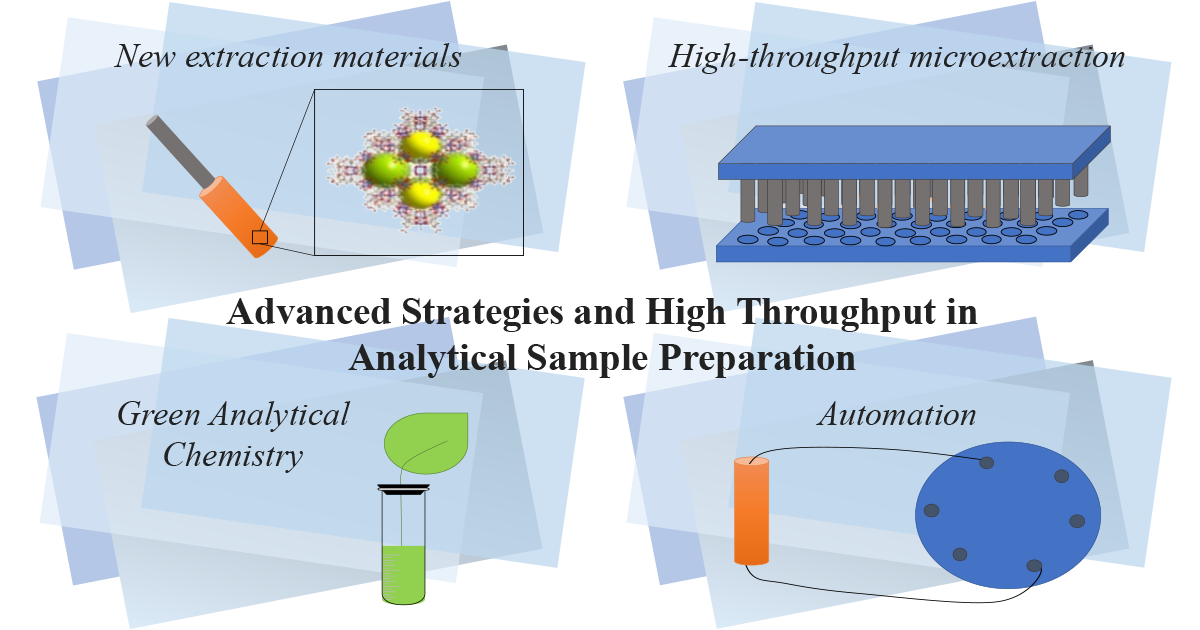Advanced Separation Strategies and High Throughput in Analytical Sample Preparation
A special issue of Separations (ISSN 2297-8739). This special issue belongs to the section "Materials in Separation Science".
Deadline for manuscript submissions: closed (10 March 2023) | Viewed by 7935

Special Issue Editors
Interests: ionic liquids; polymers; polymeric ionic liquids; analytical sample preparation; solid-phase microextraction; liquid-phase microextraction; chromatography; green analytical methods; environmental analysis; bioanalysis; food analysis
Interests: microextraction methods; miniaturized analytical sample preparation; ionic liquids and derivatives; metal-organic frameworks; environmental analysis
Special Issues, Collections and Topics in MDPI journals
Special Issue Information
Dear Colleagues,
Analytical applications often require different steps of separation, purification, extraction, clean-up, and/or preconcentration prior the analytical determination. These protocols are mandatory to ensure adequate sensitivity, interference elimination, and even compatibility with the subsequent analytical technique selected. Traditional analytical sample preparation approaches are time consuming, indeed being considered the bottleneck of the analytical method. This aspect is detrimental for their implementation in environmental quality, food technologies, and bioclinical laboratories, where a fast result is required for taking decisions/actions related to the sample analyzed. Apart of these significant drawbacks, these traditional approaches require highly specialized personnel and consume high amounts of solvents.
This Special Issue aims to highlight innovative and smarter analytical sample preparation strategies developed to be cost-effective, simpler, and more sustainable alternatives than conventional approaches. In particular, the issue focuses on microextraction and miniaturized methods using new extraction materials, greener strategies, parallel extraction, flow injection, or automation.
This Special Issue will significantly impact the research community and encourage colleagues to contribute with original research articles or reviews.
Dr. María José Trujillo-Rodríguez
Dr. Verónica Pino
Guest Editors
Manuscript Submission Information
Manuscripts should be submitted online at www.mdpi.com by registering and logging in to this website. Once you are registered, click here to go to the submission form. Manuscripts can be submitted until the deadline. All submissions that pass pre-check are peer-reviewed. Accepted papers will be published continuously in the journal (as soon as accepted) and will be listed together on the special issue website. Research articles, review articles as well as short communications are invited. For planned papers, a title and short abstract (about 100 words) can be sent to the Editorial Office for announcement on this website.
Submitted manuscripts should not have been published previously, nor be under consideration for publication elsewhere (except conference proceedings papers). All manuscripts are thoroughly refereed through a single-blind peer-review process. A guide for authors and other relevant information for submission of manuscripts is available on the Instructions for Authors page. Separations is an international peer-reviewed open access monthly journal published by MDPI.
Please visit the Instructions for Authors page before submitting a manuscript. The Article Processing Charge (APC) for publication in this open access journal is 2600 CHF (Swiss Francs). Submitted papers should be well formatted and use good English. Authors may use MDPI's English editing service prior to publication or during author revisions.
Keywords
- ionic liquids
- polymers
- nanomaterials
- metal–organic frameworks
- novel solvents
- microextraction
- miniaturization
- green methods
- automation
- parallel extraction






